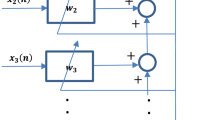Abstract
Most of the algorithms for blind separation/extraction and independent component analysis (ICA) can not separate mixtures of sources with extremely low kurtosis or colored Gaussian sources. Moreover, to separate mixtures of super- and sub-Gaussian signals, it is necessary to use adaptive (time-variable) or switching nonlinearities which are controlled via computationally intensive measures, such as estimation of the sign of kurtosis of extracted signals. In this paper, we develop a very simple neural network model and an efficient on-line adaptive algorithm that sequentially extract temporally correlated sources with arbitrary distributions, including colored Gaussian sources and sources with extremely low values (or even zero) of kurtosis. The validity and performance of the algorithm have been confirmed by extensive computer simulation experiments.
Similar content being viewed by others
References
Amari, S.: ICA of temporally correlated signals-learning algorithm, Proceedings ICA' 99: International workshop on blind signal separation and independent component analysis, Aussois, France, pp. 13-18, 1999.
Amari, S. and Cichocki, A.: Adaptive blind signal processing-neural network approaches, Proceedings of the IEEE, 86(10) (1998), 2026-2048.
Belouchrani, A., Meraim, K. A. and Cardoso, J.-F.: A blind source separation technique using second order statistics, IEEE Transaction on Signal Processing, 45 (1997), 434-444.
Cichocki, A. and Unbehauen, R.: Robust neural networks with on-line learning for blind identification and blind separation of sources, IEEE Transaction on Circuits and Systems, 43(11) (1996), 894-906.
Delfosse, N. and Loubaton, P.: Adaptive blind separation of independent sources: A deflation approach, Signal Processing, 45 (1995), 59-83.
Douglas, S.C. and Kung, S.-Y.: KuicNet algorithm for blind deconvolution, Proceedings of the 1998 IEEE Workshop on Neural Networks for Signal Processing, IEEE Press, New York, pp. 3-12, 1998.
Hyvärinen, A. and Oja, E.: A fast fixed-point algorithm for independent component analysis, Neural Computation, 9(7) (1997), 1483-1492.
Jutten, C. and Herault, J.: Blind separation of sources, Part I: An adaptive algorithm based on neuromimetic architecture, Signal Processing, 24 (1991), 1-20.
Malouche, Z. and Macchi, O.: Adaptive unsupervised extraction of one component of a linear mixture with a single neuron, IEEE Transactions Neural Networks, 9(1) (1998), 123-138.
Matsuoka, K. Ohya, M. and Kawamoto, M.: A neural net for blind separation of nonstationary signals, Neural Networks, 8(3) (1995), 411-419.
Molgedey, L. and Schuster, H. G.: Separation of a mixture of independent signals using time delayed correlations, Phys. Rev. Lett. 72(23) (1994), 3634-3637.
Pearlmutter, B. A. and Parra, L. C.: Maximum Likelihood blind source separation: A context-sensitive generalization of ICA, Proc. NIPS 96, MIT Press, 9 (1997), 613-619.
Pham, D. T. and Garat, P.: Blind separation of mixtures of independent sources through a quasi-maximum likelihood approach, IEEE Transactions on Signal Processing, 45(7) (1997), 1712-1725.
Prieto, A., Puntonet, C. G. and Prieto, B.: A neural learning algorithm for blind separation of sources based on geometric properties, Signal Processing, 64(13), (1998), 315-331.
Puntonet, C. G. and Prieto, A.: Neural network approach for blind separation of sources based on geometric properties, Neurocomputing, 18(1-3) (1998), 141-164.
Tong, L., Soon, V. C., Liu, R. and Huang, Y.: AMUSE: a new blind identification algorithm, Proceedings ISCAS, New Orleans, LA, 1990.
Thawonmas, R., Cichocki, A. and Amari, S.: A cascade neural network for blind signal extraction without spurious equilibria, IEICE Transactions on Fundamentals of Electronics, Communications and Computer Sciences, E81-A(9) (1998), 1833-1846.
Tugnait, J. K.: Blind spatio-temporal equalization and impulse response estimation for MIMO channels using a Godard cost function, IEEE Transactions on Signal Processing, 45 (1997), 268-271.
Author information
Authors and Affiliations
Rights and permissions
About this article
Cite this article
Cichocki, A., Thawonmas, R. On-line Algorithm for Blind Signal Extraction of Arbitrarily Distributed, but Temporally Correlated Sources Using Second Order Statistics. Neural Processing Letters 12, 91–98 (2000). https://doi.org/10.1023/A:1009616029367
Issue Date:
DOI: https://doi.org/10.1023/A:1009616029367




